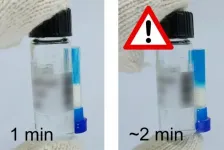Temperature sensor could help safeguard mRNA vaccines
2021-03-31
(Press-News.org) Scientists have developed vaccines for COVID-19 with record speed. The first two vaccines widely distributed in the U.S. are mRNA-based and require ultracold storage (-70 C for one and -20 C for the other). Now, researchers reporting in ACS Omega have developed a tamper-proof temperature indicator that can alert health care workers when a vial of vaccine reaches an unsafe temperature for a certain period, which could help ensure distribution of effective mRNA vaccines.
The two COVID mRNA vaccines contain instructions for building harmless pieces of the SARS-CoV-2 spike protein. Once the vaccine is injected into the body, human cells use the mRNA instructions to make the spike protein, which they temporarily display on their surface, triggering an immune response. But mRNA is highly unstable, requiring ultracold storage and transport conditions for the vaccines to remain effective. Sung Yeon Hwang, Dongyeop Oh, Jeyoung Park and colleagues wanted to develop a time-temperature indicator (TTI) to identify mRNA vaccines that are exposed to undesirable temperatures during storage or transport, so that they could be discarded.
To make their TTI, the researchers added a mixture of ethylene glycol (antifreeze), water and blue dye to a small tube and froze it in liquid nitrogen. Then, they added a white cellulose absorbent to the top of the frozen coolant, turned the tube upside down, and adhered it to a larger glass vial containing simulated vaccine at -70 C. At temperatures above -60 C, the antifreeze mixture melted, and the dye diffused into the white absorbent, turning it light blue. The color change happened about 2 minutes after the simulated vaccine was exposed to a higher temperature. Importantly, exposures of less than 2 minutes -- which are unlikely to impair vaccine efficacy -- did not turn the TTI blue. The color change persisted if the tube was refrozen at -70 C, making the system tamper-proof. By changing the coolants or their mixing ratio, or by using different absorbents, the TTI could be tailored to monitor the ideal storage conditions of different mRNA vaccines, the researchers say.
INFORMATION:
The authors acknowledge funding from the Korea Research Institute of Chemical Technology.
The paper is freely available as an ACS AuthorChoice article here.
For more of the latest research news, register for our upcoming meeting, ACS Spring 2021. Journalists and public information officers are encouraged to apply for complimentary press registration by emailing us at newsroom@acs.org.
The American Chemical Society (ACS) is a nonprofit organization chartered by the U.S. Congress. ACS' mission is to advance the broader chemistry enterprise and its practitioners for the benefit of Earth and all its people. The Society is a global leader in promoting excellence in science education and providing access to chemistry-related information and research through its multiple research solutions, peer-reviewed journals, scientific conferences, eBooks and weekly news periodical Chemical & Engineering News. ACS journals are among the most cited, most trusted and most read within the scientific literature; however, ACS itself does not conduct chemical research. As a specialist in scientific information solutions (including SciFinder® and STN®), its CAS division powers global research, discovery and innovation. ACS' main offices are in Washington, D.C., and Columbus, Ohio.
To automatically receive news releases from the American Chemical Society, contact newsroom@acs.org.
Follow us: Twitter | Facebook
[Attachments] See images for this press release:

ELSE PRESS RELEASES FROM THIS DATE:
2021-03-31
Increased consumption of flavanols - a group of molecules occurring naturally in fruit and vegetables - could protect people from mental stress-induced cardiovascular events such as stroke, heart disease and thrombosis, according to new research.
Researchers have discovered that blood vessels were able to function better during mental stress when people were given a cocoa drink containing high levels of flavanols than when drinking a non-flavanol enriched drink.
A thin membrane of cells lining the heart and blood vessels, when functioning efficiently the endothelium helps ...
2021-03-31
LAWRENCE -- New research from the University of Kansas END ...
2021-03-31
Meat and fish fraud are global problems, costing consumers billions of dollars every year. On top of that, mislabeling products can cause problems for people with allergies, religious or cultural restrictions. Current methods to detect this fraud, while accurate, are slower than inspectors would like. Now, researchers reporting in ACS' Journal of Agricultural and Food Chemistry have optimized their handheld MasSpec Pen to identify common types of meat and fish within 15 seconds.
News stories of food fraud, such as beef being replaced with horse ...
2021-03-31
SAN ANTONIO (March 31, 2021) -- Insomnia and obstructive sleep apnea have increased dramatically among active-duty military members over a 14-year period, 2005 through 2019.
Insomnia increased 45-fold and sleep apnea went up more than 30-fold, according to a study led by The University of Texas Health Science Center at San Antonio (UT Health San Antonio).
The study found that the most likely military member to be diagnosed with either sleep disorder was married, male, white, a higher-ranking enlisted Army service member and age 40 or older.
The researchers compared medical codes that represent diagnosis of sleep apnea or insomnia in active-duty Army, Navy, Marine Corps and Air Force personnel. No medical ...
2021-03-31
Risks of SARS-CoV-2 coronavirus infection for long-stay nursing home residents were mainly dependent on factors in their nursing homes and surrounding communities, according to a large study led by a researcher at the Johns Hopkins Bloomberg School of Public Health.
By contrast, the study found that the risks of being hospitalized with, and of dying from, COVID-19, depended more on patient-specific characteristics such as age and body mass index--although the mix of factors linked to hospitalization was distinct from the mix of factors linked to mortality.
The study, which appears online March 31 in JAMA Network Open, detailed COVID-19 risk factors among more than 480,000 long-stay nursing home residents in the ...
2021-03-31
Roughly five years ago, Institute Head Prof. Dr. William (Bill) Martin and his team introduced the last universal common ancestor of all living organisms and named it "LUCA". It lived approximately 3.8 billion years ago in hot deep sea hydrothermal vents.
Now the evolutionary biologists in Duesseldorf have described a further ancient cell named "LBCA" ("Last Bacterial Common Ancestor"). It is the ancestor of today's largest domain of all living organisms: Bacteria. In Communications Biology, they report on their new research approaches which led to the successful prediction ...
2021-03-31
Every day, people are exposed to microplastics from food, water, beverages and air. But it's unclear just how many of these particles accumulate in the human body, and whether they pose health risks. Now, researchers reporting in ACS' Environmental Science & Technology have developed a lifetime microplastic exposure model that accounts for variable levels from different sources and in different populations. The new model indicates a lower average mass of microplastic accumulation than previous estimates.
Microplastics, which are tiny pieces of plastic ranging in size from 1 μm to 5 mm (about the ...
2021-03-31
In Brazil, researchers are puzzling over socioeconomic and environmental indicators that do not add up. They are concerned with what they call the São Paulo Macrometropolitan Area, a mega-region comprising five metropolitan areas in the state of São Paulo with a total of 180 municipalities, some of which provide ecosystem services while others receive them. The problem is that the former, which provide the others with water, food and power generation inputs, suffer from steep inequities in terms of defective human development and lack of social inclusion.
"Urban centers have always been ...
2021-03-31
Glass, rubber and plastics all belong to a class of matter called amorphous solids. And in spite of how common they are in our everyday lives, amorphous solids have long posed a challenge to scientists.
Since the 1910s, scientists have been able to map in 3D the atomic structures of crystals, the other major class of solids, which has led to myriad advances in physics, chemistry, biology, materials science, geology, nanoscience, drug discovery and more. But because amorphous solids aren't assembled in rigid, repetitive atomic structures like crystals are, they have defied researchers' ability to determine their atomic structure with the same level of precision.
Until now, that is. ...
2021-03-31
Sugar practically screams from the shelves of your grocery store, especially those products marketed to kids.
Children are the highest consumers of added sugar, even as high-sugar diets have been linked to health effects like obesity and heart disease and even impaired memory function.
However, less is known about how high sugar consumption during childhood affects the development of the brain, specifically a region known to be critically important for learning and memory called the hippocampus.
New research led by a University of Georgia faculty member in collaboration with a University ...
LAST 30 PRESS RELEASES:
[Press-News.org] Temperature sensor could help safeguard mRNA vaccines





